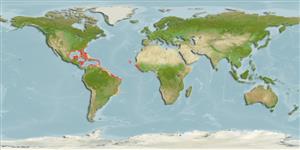Environment: milieu / climate zone / depth range / distribution range
Ecologia
marino demersale; distribuzione batimetrica 1 - 120 m (Ref. 36484), usually ? - 15 m (Ref. 3589). Tropical; 40°N - 24°S, 99°W - 9°E (Ref. 5222)
Western Atlantic: Massachusetts, USA and Bermuda to the Gulf of Mexico, the Caribbean and southern Brazil. Eastern Atlantic: Ascension and St. Helena islands; dubious records from the Canary Islands, Cape Verde and South Africa (Ref. 1496, 1953, 6572) are discussed by Heemstra (Ref. 6512). Also recorded from eastern Atlantic from Sao Tome in the Gulf of Guinea and from the Azores (Portugal) (Ref. 089707).
Length at first maturity / Size / Peso / Age
Maturity: Lm 30.4, range 25 - 36 cm
Max length : 65.0 cm TL maschio/sesso non determinato; (Ref. 118680); common length : 35.0 cm TL maschio/sesso non determinato; (Ref. 5217); peso massimo pubblicato: 4.5 kg (Ref. 118249); Età massima riportata: 25 anni (Ref. 118249)
Spine dorsali (totale) : 11; Raggi dorsali molli (totale) : 16 - 17; Spine anali: 3; Raggi anali molli: 8. Maxilla without scales. Preopercle with rounded, only slightly enlarged, spines at its angle. Opercle with 3 flat spines, middle one the largest. Pelvic fins shorter than pectorals and shorter than longest dorsal spine. Bases of soft dorsal and anal fins covered with scales and thick skin. 2 or 3 dark saddles along base of dorsal fin and another on top of caudal peduncle. Tan with red spots on head, body and fins, spots becoming larger ventrally (Ref. 26938); characterized further by: body depth less than head length, 2.6-3.2 times in SL; head length 2.1-2.5 in SL; interorbital area flat or slightly concave; preopercle evenly serrate; smooth subopercle and interopercle; subequal posterior and anterior nostrils (Ref. 089707).
Inhabits rocky reefs. Usually solitary (Ref. 29). Difficult to approach (Ref. 9710). Juveniles often seen in rockpools (Ref. 86997). Feeds mainly on crabs (67%) and fishes (20%). In the Ascension I., feeds on juvenile Melichthys niger and young sea turtles. Its flesh is of good quality. Marketed fresh. Angling: Like other grouper, rock hind are caught by fishing at the right depth over an irregular bottom (Ref. 84357).
Life cycle and mating behavior
Maturità | Riproduzione | Deposizione | Uova | Fecundity | Larve
Heemstra, P.C. and J.E. Randall, 1993. FAO Species Catalogue. Vol. 16. Groupers of the world (family Serranidae, subfamily Epinephelinae). An annotated and illustrated catalogue of the grouper, rockcod, hind, coral grouper and lyretail species known to date. Rome: FAO. FAO Fish. Synop. 125(16):382 p. (Ref. 5222)
IUCN Red List Status (Ref. 130435: Version 2024-2)
Threat to humans
Reports of ciguatera poisoning (Ref. 31172)
Human uses
Pesca: elevato interesse commerciale; Pesce da pesca sportiva: si
Strumenti
Special reports
Download XML
Fonti Internet
Estimates based on models
Preferred temperature (Ref.
123201): 24.2 - 28.1, mean 27.3 °C (based on 1043 cells).
Phylogenetic diversity index (Ref.
82804): PD
50 = 0.5000 [Uniqueness, from 0.5 = low to 2.0 = high].
Bayesian length-weight: a=0.01202 (0.00755 - 0.01914), b=3.10 (2.97 - 3.23), in cm total length, based on LWR estimates for this species & Genus-body shape (Ref.
93245).
Trophic level (Ref.
69278): 3.5 ±0.4 se; based on diet studies.
Resilienza (Ref.
120179): Basso, tempo minimo di raddoppiamento della popolazione 4.5 - 14 anni (K=0.11).
Fishing Vulnerability (Ref.
59153): High vulnerability (63 of 100).
Nutrients (Ref.
124155): Calcium = 86.2 [37.2, 188.8] mg/100g; Iron = 0.991 [0.462, 2.360] mg/100g; Protein = 17.7 [16.1, 19.2] %; Omega3 = 0.203 [0.104, 0.371] g/100g; Selenium = 71.6 [34.9, 165.7] μg/100g; VitaminA = 32.5 [8.0, 126.3] μg/100g; Zinc = 1.24 [0.78, 2.01] mg/100g (wet weight);
